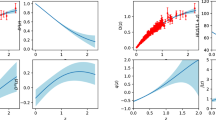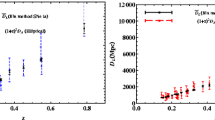Drawing on astronomical discoveries made in the past 25 years, the paper discusses possible causes of the phenomenon perceived as the “accelerated expansion of the universe.” In 1998, to confirm the “accelerated expansion of the universe,” the High-Z SN Search Team tested and rejected the hypothesis about the effect produced by a local void — Hubble bubble — using data on 44 Type Ia supernovae (SNe Ia), which was believed to be an alternative to the positive cosmological constant. Also in 1998, the present author and specialists of the Computing Center of the Academy of Sciences (CC RAS) discovered divergent dipole anisotropy in the redshift of 383 quasars and radio galaxies along the Virgo – Leo ↔ Eridanus – Aquarius axis when testing the MCM-stat M program for multivariate statistical analysis using standard reference data. In 2007, the issues associated with anisotropy caught the attention of cosmologists, while in 2016, the High-Z SN Search Team and the Carnegie–Chicago Hubble program initiated a discussion about the impasse in cosmology. An additional analysis revealed that the dipole anisotropy in the redshift of SNe Ia, as well as radio galaxies, is inversely oriented with respect to the dipole anisotropy of quasars.
Similar content being viewed by others
Notes
As a function of time, the Hubble constant is called the Hubble parameter [2].
Perhaps the terms “dark substance” and “dark field” would be more appropriate.
Astronomical term — departure of the local value of the Hubble constant H0 from its globally averaged value, a local void in the matter distribution [13].
According to Hubble’s law cz = H0r, a speed of about 7000 km·s−1 corresponds to z ~ 0.02 or a distance of z ~ 108 Mpc.
In the Friedmann-Robertson-Walker model, ΩΛ is called the dark energy density parameter.
RRT 507-98. GSI. Measurement Problems. Solution Methods. Terms and Definitions.
References
S. F. Levin, Meas. Tech., 63, No. 10, 780–797 (2021), https://doi.org/10.1007/s11018-021-01854-z.
N. A. Bahcall, Hubble’s Law and the Expanding Universe, in: Proc. Natl Acad. Sci. USA, 112, 3173–3175 (2015), https://doi.org/10.1073/pnas.1424299112.
Planck Collaboration. Planck Intermediate Results. XLVI. Reduction of Large-Scale Systematic Effects in HFI Polarization Maps and Estimation of the Reionization Optical Depth. arXiv:1605. 02985v2 [astro-ph.CO] (May 26, 2016).
A. G. Riess et al., Astrophys. J., 826, No. 1, 56, https://doi.org/10.3847/0004-637X/826/1/56.
M. Visser, Classical Quant. Grav., 21, No. 11, 2603 (2004), https://doi.org/10.1088/0264-9381/21/11/006.
A. G. Riess et al., Observational Evidence from Supernovae for an Accelerating Universe and a Cosmological Constant, Astron. J., 116, 1009–1038 (1998).
M. V. Sazhin, Phys. Usp., 47, 187–194 (2004), https://doi.org/10.1070/PU2004v047n02ABEH001630.
S. Perlmutter et al., Measurements of Ω and Λ from 42 High-Redshift Supernovae, Astrophys. J., 517, 565–586 (1999).
R. L. Beaton, W. L. Freedman, B. F. Madore, et al., Astrophys. J., 832, No. 2, 210 (2016), https://doi.org/10.3847/0004-637X/832/2/210.
W. L. Freedman, https://doi.org/10.48550/arXiv.1706.02739 (July 13, 2017).
A. Riess et al., Astrophys. J., 876, No. 1, 85 (2019), https://doi.org/10.3847/1538-4357/ab1422.
A. Elcio et al., J. High Energy Phys., 34, 49–211 (2022), https://doi.org/10.1016/j.jheap.2022.04.002.
A. Conley, R. G. Carlberg, J. Guy, D. A. Howell, S. Jha, A. G. Riess, and M. Sullivan, Astrophys. J., 664, No. 1, L13–L16 (2007), https://doi.org/10.1086/520625.
I. Zehavi, A. G. Riess, R. P. Kirshner, and A. Dekel, Astrophys. J., 503, No. 2, 483 (1998), https://doi.org/10.1086/306015.
S. F. Levin, Meas. Tech., 59, No. 8, 791–802 (2016), https://doi.org/10.1007/s11018-016-1047-5.
A. Kogut et al., Astrophys. J., 419, 1–6 (1993), https://doi.org/10.1086/173453.
D. T. Wilkinson and R. B. Partridge, Nature, 215, 719 (1967), https://doi.org/10.1038/215719a0.
R. P. Kirshner, A. Jr. Oemler, P. L. Schechter, and S. A. Shectman, Astrophys. J., 314, 493–506 (1987), https://doi.org/10.1086/165080.
G. Aldering, Filling the Void – Understanding the Formation of the Bootes Void in Intergalactic Space, Brief Article, Disco. Mag., (1995), available at: http://findarticles.com/p/articles/mi_m1511/is_n8_v16/ai_17253874 (accessed: Jan. 11, 2023).
I. D. Karachentsev and D. I. Makarov, Galaxy Interactions in the Local Volume, in: J. E. Barnes and D. B. Sanders (eds.), Galaxy Interactions at Low and High Redshift. International Astronomical Union, 186 (1999), https://doi.org/10.1007/978-94-011-4665-4_22.
S. F. Levin, A. N. Lisenkov, O. V. Sen’ko, and E. I. Xarat’yan, Sistema Metrologicheskogo Soprovozhdeniya Staticheskix Izmeritel’ny’x Zadach “MMK-stat M,” user manual, Gosstandart RF, VC RAN Publ., Moscow (1998).
K. R. Lang, Astrophysical Formulae: A Compendium for the Physicist and Astrophysicist, Springer-Verlag, Berlin, N.Y. (1980), https://doi.org/10.1007/978-3-662-21642-2.
S. F. Levin, in: Abstracts of Papers X Russian Gravitation Conf. Teoreticheskie i Eksperimental’nye Problemy Obshchej Teorii Otnositel’nosti i Gravitacii, June 20–27, 1999, Vladimir, RGO Publ., Moscow (1999).
S. F. Levin, On Spatial Anisotropy of Redshift in Spectrums of Extragalactic Sources, in: Physical Interpretations of Relativity Theory: Proc. XV Int. Meeting, Moscow, July 6–9, 2009, ed. by M. C. Duff y, V. O. Gladyshev, A. N. Morozov, and P. Rovlands, Moscow, Liverpool, Sunderland, BMSTU (2009), pp. 234–240.
S. F. Levin, Izmer. Tekh., No. 10, 11–18 (2022), https://doi.org/10.32446/0368-1025it.2022-10-11-18.
S. F. Levin, Meas. Tech., 64, No. 4, 273–281 (2021), https://doi.org/10.1007/s11018-021-01929-x.
S. F. Levin, Meas. Tech., 63, No. 11, 849–855 (2021), https://doi.org/10.1007/s11018-021-01874-9.
S. F. Levin, Matematicheskaya Teoriya Izmeritel’nyh Zadach: Prilozheniya. Kalibrovka Kosmicheskaya i Zemnaya – Metrologicheskij i Nauchnyj Tupik? Kontr.-Izmer. Pribory Sist., No. 2, 35–38 (2018).
S. F. Levin, Izmeritel’naya Zadacha Identifikacij Anisotropii Krasnogo Smeshcheniya, Metrologiya, No. 5, 3–21 (2010).
S. F. Levin, Meas. Tech., 56, No. 3, 217–222 (2013), https://doi.org/10.1007/s11018-013-0182-5
S. F. Levin, Meas. Tech., 57, No. 4, 378–384 (2014). https://doi.org/10.1007/s11018-014-0464-6.
S. F. Levin, Meas. Tech., 60, No. 5, 411–417 (2017), https://doi.org/10.1007/s11018-017-1211-6.
Y. Hoff man, D. Pomarède, R. B. Tully, and H. Courtois, The Dipole Repeller, arXiv:1702.02483v1 [astro-ph.CO] (Feb. 8, 2017).
D. Proust et al., The Shapley Supercluster: the Largest Matter Concentration in the Local Universe. Reports from Observers, The Messenger, No. 124, 30–31 (2006), available at: https://www.eso.org/sci/publications/mes-senger/archive/no.124-jun06/messenger-no124-30-31.pdf (accessed: Jan., 25, 2023).
What is the Great Attractor? Universe Today, July 14, 2014, available at: https://www.universetoday.com/113150/whatis-the-great-attractor/ (accessed: Jan. 11, 2023).
M. Cruz, L. Cayón, E. Martínez-González, P. Vielva, and J. Jin, Astrophys. J., 655, 11–20 (2007), https://doi.org/10.1086/509703.
D. J. Schwarz and B. Weinhorst, Astron. Astrophys., 474, No. 3, 717–729 (2007), https://doi.org/10.1051/0004-6361:20077998.
M. L. McClure and C. C. Dyer, New Astron., 12, No. 7, 533–543 (2007), https://doi.org/10.1016/j.newast.2007.03.005.
I. Horváth, Z. Bagoly, J. Hakkila, and L. V. Tóth, Astron. Astrophys., 8, No. 584 (2015), https://doi.org/10.1051/0004-6361/201424829.
R. B. Tully, H. Courtois, Y. Hoff man, and D. Pomarède, Nature, 513, 7516 (2014), https://doi.org/10.1038/nature13674.
S. F. Levin, Identification of Interpreting Models in General Relativity and Cosmology, in: Physical Interpretation of Relativity Theory: Proc. Int. Sci. Meeting PIRT-2003, Moscow, June 30 – July 3, 2003, Moscow, Liverpool, Sunderland, Coda (2003), pp. 72–81.
G. Feldman and R. Cousins, Phys. Rev. D, 57, No. 7, 3873–3889 (1998), https://doi.org/10.1103/PhysRevD.57.3873.
G. Rosi, F. Sorrentino, L. Cacciapuoti, et al., Nature, 510, 518–521 (2014), https://doi.org/10.1038/nature13433.
T. Quinn, H. Parks, C. Speake, and R. Davis, Phys. Rev. Lett., 111, No. 10, 101102 (2013), https://doi.org/10.1103/PhysRevLett.111.101102.
S. F. Levin, Meas. Tech., 62, No. 1, 7–15 (2019), https://doi.org/10.1007/s11018-019-01578-1.
S. F. Levin, Phys. Atom. Nucl., 78, No. 13, 1528–1533 (2015), https://doi.org/10.1134/S1063778815130190.
D. Yu. Tsvetkov, N. N. Pavlyuk, O. S. Bartunov, and Yu. P. Pskovskii, Supernovae Catalogue, State Astronomical Sternberg Institute, Moscow (2005), available at: www.astronet.ru/db/sn/catalog.html (accessed: Jan. 11, 2023).
I. Vuchkov, L. Boyadzhieva, and E. Solakov, Prikladnoj Linejny’j Regressionny’j Analiz, transl. by Yu. P. Adler, Finansy i Statistika Publ., Moscow (1987).
S. F. Levin, Meas. Tech., 63, No. 11, 940–949 (2021), https://doi.org/10.1007/s11018-021-01876-7.
J. F. Smoot, Nobel lecture, Stockholm, December 8, 2006, Rev. Mod. Phys., 79, 1349 (2007), https://doi.org/10.1103/RevModPhys.79.1349.
Author information
Authors and Affiliations
Corresponding author
Additional information
Translated from Izmeritel’naya Tekhnika, No. 2, pp. 4–11, February, 2023.
Rights and permissions
Springer Nature or its licensor (e.g. a society or other partner) holds exclusive rights to this article under a publishing agreement with the author(s) or other rightsholder(s); author self-archiving of the accepted manuscript version of this article is solely governed by the terms of such publishing agreement and applicable law.
About this article
Cite this article
Levin, S.F. Cosmological Distance Scale. Part 14: “Hubble Bubble” and the Gravitational Dipole. Meas Tech 66, 81–87 (2023). https://doi.org/10.1007/s11018-023-02193-x
Received:
Accepted:
Published:
Issue Date:
DOI: https://doi.org/10.1007/s11018-023-02193-x




